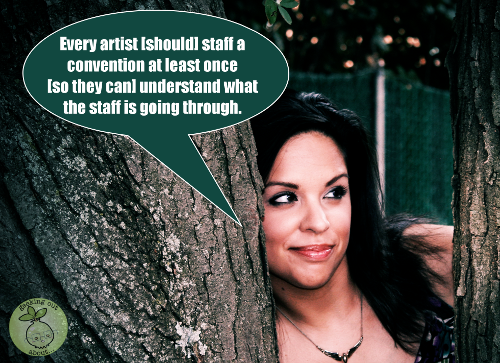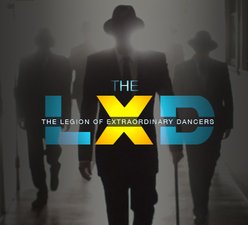
As a newbie geek, a major event you learn about is the genre convention. When I started out, I thought it pretty amazing there was a gathering where you could leave your home and go to geek out with your friends or make new ones while enjoying the thing you loved.
The more I went to conventions as a journalist—first for Sequential Tart and then Anime Insider—the more I became interested in how they were run. It wasn’t long before I was volunteering first in the publications department, then later becoming a senior staffer in the guest relations departments of some East Coast anime conventions.
I’ve since returned to my roots as an attendee, but after being a panelist for six panels(!) at the recent CONvergence in Minneapolis, MN, I started to wonder: What’s it really like to be on the planning committee of a genre convention? What changes have taken place while I was “away?”
I asked Intervention Convention’s founder Onezumi Hartstein and its social media manager (and former Geeking Out About contributor) Kara Dennison to chat with me over Skype about what it takes to run a pan-fandom convention in the 21st century.
Secret Origins of a Convention Runner
As the three of us knew each other from the East Coast anime convention scene, I had an idea that going to genre conventions was a huge part of their lives, but I didn’t realize how much of an influence it was.
Dennison first started attending local sci-fi conventions and then later branched out to anime cons with the William and Mary Anime Society club in 2000. She said, “I sort of fell into staffing, as you do,” and starting with stints with the karaoke and cosplay masquerade departments, Dennison thinks she’s been involved in every major department of an anime or sci-fi con which doesn’t involve A/V or other tech.
Hartstein’s first conventions were sci-fi cons, comic book conventions (for which she cosplayed and won first prize), and a Xena: Warrior Princess ‘zine fest. That was her first experience as a staff member at a convention. Her later staffing experiences came in 2006 when she became the head of the webcomic guests branch of Guest Relations for Katsucon. “I entered staffing as a department head. I didn’t do any of the lower-level [jobs like] security, gophering, badge-checking,” she said.
And what have they learned as a result of being both convention attendees and staffers?
“[A] big thing I learned is that one should staff for a lot of conventions in the same region,” Dennison said. “A lot of cons will have the same staff in different positions. I’ve worked with the same people at Anime Mid Atlantic as I’ve worked with at Katsucon and Nekocon. I’ve worked with the same people at Marscon as I’ve worked with at Raven Con. The cons don’t have to be literally connected to share the same staff and the big thing I’ve learned is that [how] to ‘swap out the captain’s chair’,” she added, laughing.
Hartstein takes a different approach to convention staffing. “For me, I think staffing cons was the key to getting my career [to] where it is today because I actually learned how to approach my business relationships as a collaboration after I started staffing,” she said. “I tell every artist—and a lot of them don’t listen to me—to staff a con at least once [so they can] understand what the staff is going through. Some exhibitors and artists can be unrealistically demanding to the point where it’s ridiculous and they don’t realize they’re being that way. [Things like] blaming the con for their failings [when] they haven’t even done the first step in it, where they have to at least participate in the collaboration. That really gets on my nerves.”
When asked to elaborate on what “participating in the collaboration” means to her, Hartstein explained by email:
When an artist doesn’t promote their appearance in advance and isn’t interested in actually participating with the convention’s programming their weekend at any con will suffer. The best way to increase sales and increase visibility for your brand is to leverage your current fans and followers in concert with the convention opportunity. It’s a clear win/win. You help the con and the con is helping you in return. The reason I’ve been able to land some high-paying and high-visibility opportunities is because when I exhibit at an event I make sure to tell my readers that I will be there and ask that they join me. Then I have multiple people at the con talking about me from the beginning and that in turn gets me more new people.
It’s even better if I can participate in any panels. Those immediately showcase the panelists as experts. The way I approach this also makes me more desirable as a paid guest speaker because every event knows that I am looking out for them just as much as I am looking out for myself. I bring as many people as I can in the door and they do their best to run an event that will allow me to show my work.
This may all seem like basic stuff, but I often hear artists get nasty and demanding toward conventions while simultaneously bringing nothing to the table and not wanting to participate in anything. I’ve worked both sides. I’ve been an exhibiting artist for over 10 years and a con runner for almost that many years. I am well aware of how it feels to be an artist trying to be seen. I am also aware of how it feels to be a con staffer who has suffered greatly to make an event run well [only] to get crapped on by an artist who didn’t promote their [own] appearance — yet somehow in their mind it’s not their fault but the event’s fault.
I freely admit I was one of these people back in the day before I realized how horrendous I was being. I am glad I realized it and stopped before it ruined my career. Artists should be treated with respect, but on the flip side, con runners are not that different from artists. They are making something difficult on a small budget for free. They shouldn’t be disrespected either.
A lot goes into running an event, so usually what you are seeing on the surface has a larger story. It’s really uneducated to blame someone without knowing everything that happened. For example, perhaps they were late setting the tables up. That doesn’t mean they are awful people or bad at their jobs. It could mean that someone’s mom was rushed to the hospital right when setup was to start, and now you are yelling at that same person who rushed back from the hospital in order to make sure the artists were taken care of.

